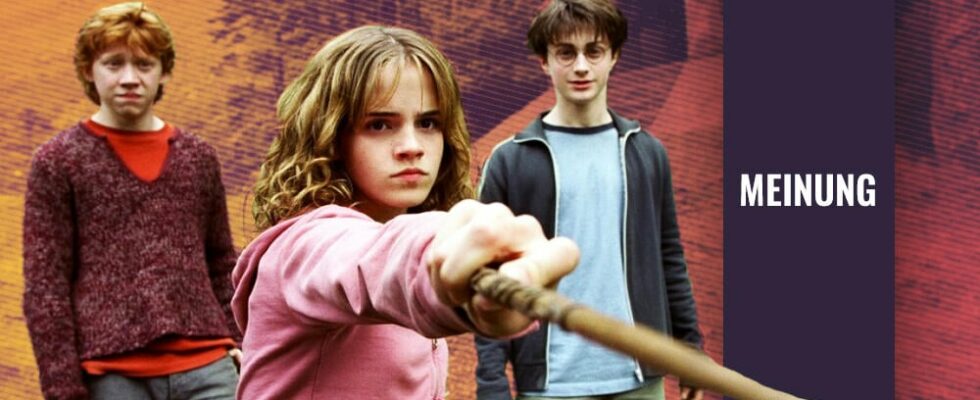There is only one correct answer to the question of which Harry Potter film is the best: Harry Potter and the Prisoner of Azkaban. The third film in the popular fantasy series was released in British cinemas on May 31, 2004 (and came to Germany three days later). We are therefore celebrating its 20th anniversary today and this is a good reason to once again highlight the genius of the film that changed everything.
With Harry Potter and the Prisoner of Azkaban, the fantasy series reached true greatness 20 years ago
We should actually emulate Hagrid and bake a cake with the spelling-questionable inscription “Happee Birtdae, Harry”. Instead, we do the next best thing and, for the 20th anniversary of Harry Potter and the Prisoner of Azkaban, we remember a surprising rebirth which set new course not only for the Hogwarts Express.
With two captivatingly beautiful children’s films, the Harry Potter franchise had already found its cinematic fan base in the early 2000s. It was all the more surprising that, after the great director Chris Columbus, the lesser-known Mexican filmmaker Alfonso Cuarón took over part 3. Producer David Heyman explained the reason for the Harry Potter directorial choice by saying that Cuarón had sensitively told the story of the end of a youth in Y Tu Mama Tambien, while the third Potter film had Harry, Ron and Hermione into teenage years In keeping with this, the acting of the magical trio of Daniel Radcliffe, Rupert Grint and Emma Watson took a noticeable leap forward here.
Warner
Harry Potter 3 matures into teenagers in part 3
The choice of arthouse filmmaker Cuarón was a bold move that paid off: The third film gets rid of his baby fat and stages the Hogwarts students as serious aspiring adults. From the first scary Dementor meeting to the upending showdown in the Shrieking Shack, the Tone darker and more serious. The tension was no longer broken by acting exaggerations (such as the cartoonish screaming of a three-headed dog).
Magic was suddenly allowed to be realistic and humanly grounded. No wonder that the FSK rating climbed to 12 from then on. Of course, the young witches and wizards matured according to the book, but Part 3 set the cinematic pace that became the signpost for all subsequent Harry Potter installments.
Harry Potter 3 took the franchise to a new cinematic level
This development was also reflected in the imagery: Harry Potter and the Prisoner of Azkaban completely redesigned the Hogwarts castle grounds: Suddenly, paths between iconic locations made sense and the school gained new bridges, stairs and extensions. Just like the more complex inner life of a teenager, the boarding school was able to mature into a fully-fledged character.
Warner
Harry Potter 3 expands Hogwarts
With the playful camera by Michael Seresin, we explored this new freedom, flying and swaying. The Whomping Willow presented itself as a clock of the seasons, which reliably located us in the passing school year. When the encounter with his godfather shook Harry’s life, the image tipped over as a metaphor. This well thought-out production made Harry Potter 3 a visual experience.
Added to this was the decision to take the students out of their uniform black wizarding cloaks in their free time and put them in “normal” clothes. This gave the entire franchise a contemporary feel that made it even easier for all Muggles to identify with it.
Warner
Time travel makes Harry Potter 3 even more complex
Elements such as time travel also add a narratively sophisticated complexitywhich was no longer child’s play to understand. Together with magic cards, betrayal of friends and the concept of Animagi shapeshifters, the franchise grew in many layers into the past, in which Harry’s parents’ generation led a life as Marauders.
Narrative ambivalence: Harry Potter 3 has the best characters and doesn’t need Voldemort
Harry Potter 3 is full of wisdom and groundbreaking characters whose life lessons do not lead to easy results. In all other Potter films, Voldemort is the clear enemy. In part 3, he does not even appear. And we do not miss him when the cast is so rich in more interesting magical characters. The third film celebrates the battle of good against evil rather than the Ambivalence of his characters.
Warner
Harry Potter 3 introduces Sirius Black
These nuances of conflict begin with the proud hippogriff, who is both impressive and difficult, and are symbolically reflected in the monster book, which must be stroked. Gary Oldman, introduced here as Harry’s godfather Sirius Black, is and remains one of the most popular characters in the series – not least because he enters the third film as a villain and leaves as a hero. A similar division creates Remus Lupin (David Thewlis), who is an excellent teacher and, as a werewolf, is still a tragic threat (and AIDS metaphor).
Amazing twists and re-evaluations of old ideas are good lessons for the Hogwarts staff and audience alike. Without Alfonso Cuarón’s film, the franchise might have taken a different direction. The remarkable decision to re-orient an already successful franchise like Harry Potter in part 3 thus gave us a Fantasy wonder that still has the same astonishing effect 20 years later like back then. If there wasn’t any magic involved…
Happee Birthdae, Azkaban Harry.
